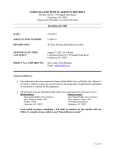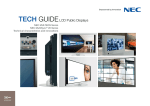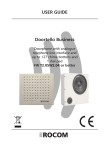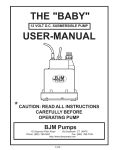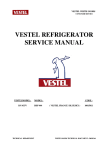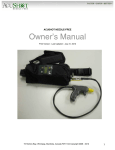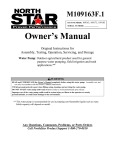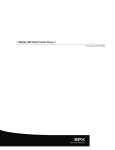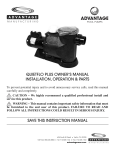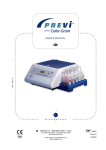Download OPERATION AND MAINTENANCE OF SELF-PRIMING
Transcript
Owner’s Manual Models: 2S5P & 3S5P OPERATION AND MAINTENANCE OF SELF-PRIMING CENTRIFUGAL TRASH PUMPS PEDESTAL DRIVE WARNING!! DO NOT USE PUMP IN EXPLOSIVE ATMOSPHERE DO NOT PUMP VOLATILE OR FLAMMABLE LIQUIDS Installation & Operating Instructions Self-Priming Centrifugal Pump BASIC PUMP INSTRUCTIONS INSPECTION: The pump assembly was tested and inspected before shipment. Before installation, inspect the pump for damage which may have occurred during shipment. Check the following: 1. Inspect for cracks, damaged threads, and other obvious damage. 2. Check and tighten loose bolts, nuts and other attaching hardware. 3. Carefully read all warning and cautions in the manual and on tags and labels on the pump. 4. Note the direction of rotation indicated on the pump. Check that the pump shaft rotates counterclockwise facing the pump suction. CAUTION: Only operate this pump in the direction indicated by the arrow on the bearing pedestal. Otherwise, the impeller could become loosened from the shaft and seriously damage the pump. PLACING PUMP: Locate the pump as close to the liquid to be pumped as practical, but never higher than 25 feet. Level mounting is essential for proper operation. The pump may have to be supported to provide level operation and to eliminate vibration. SUCTION AND DISCHARGE PIPING: Either pipe or hose may be used for suction and discharge lines. If hose is used in suction lines, it must be the rigid-wall, reinforced type to prevent collapse under suction. Using pipe couplings in the suction lines is not recommended. Keep suction and discharge lines as straight as possible and make minimum use of elbows and fittings to minimize friction losses. the pump. If hoses are used, they should have adequate support to secure them when filled with liquid. SUCTION LINES: The suction line must be as short and direct as possible and the line must always slope upward to the pump from the source of the liquid. The suction line should not exceed 30 feet in length. Suction lines should be the same size as the pump inlet. Use pipe sealant on the threads of the fittings. STRAINERS: A strainer is furnished with the pump, be certain to use it. It is provided with openings small enough to prevent big stones, etc. from damaging the impeller. Keep strainer clean. If possible, suspend it to keep it from working into sediment. VALVES: A check valve in the discharge line is normally recommended, but it is not necessary in low discharge head applications. If a throttling valve is desired in the discharge line, use a valve as large as the largest pipe to minimize friction losses. With high discharge heads, it is recommended that a throttling valve and a check valve be installed in the discharge line to protect the pump from excessive shock pressure and reverse rotation when it is stopped. BYPASS LINES: If it is necessary to permit the escape of air to atmosphere during initial priming or in the repriming cycle, install a bypass line between the pump and the discharge check valve. The bypass line should be sized so that it does not affect pump discharge capacity. ALIGNMENT: The alignment of the pump and its power source is critical for trouble-free mechanical operation. The driver and pump must be mounted on a common base so that their shafts are aligned with and parallel to each other. It is imperative that alignment be checked after the pump and piping are installed, and before operation. WARNING: When checking alignment, disconnect the power source to ensure that the pump will remain inoperative. FIGURE 1 illustrates a typical installation. A bypass line may be required for priming on high discharge head applications. CONNECTIONS TO PUMP: Before tightening a connection pipe, align it exactly with the pump port. Never pull a pipe line into place by tightening the flange bolts and/or couplings. Lines near the pump must be independently supported to avoid strain on COUPLED DRIVES: When using couplings, the axis of the power source must be aligned to the axis of the pump shaft in both the horizontal and vertical planes. Most couplings require a specific gap or clearance between the driving and the driven shafts. Refer to the coupling manufacturer’s service literature. The coupling is in alignment when the hub ends are the same distance apart at all points. (See Figure 2) casing has evaporated. Once the pump casing has been filled, the pump will prime and reprime as necessary. To fill the pump, remove the pump casing fill plug at the top of the casing and add clean liquid until the pump is filled. Replace the fill plug before operating the pump. FIGURE 2 Aligning Couplings Check parallel adjustment by laying a straightedge across both coupling rims at the top, bottom, and side. When the straightedge rests evenly on both halves of the coupling, the coupling is in horizontal parallel alignment. If the coupling is misaligned, use a feeler gauge between the coupling and the straightedge to measure the amount of misalignment. V-BELT DRIVES: recommended. V-Belt drives are not WARNING: Do not operate the pump without a guard over the rotating parts. Exposed rotating parts can catch clothing, fingers, or tools, causing severe injury to personnel. PUMP BEARING PEDESTAL: The shaft bearings are permanently lubricated by the manufacturer and sealed. Routine maintenance is not required. POWER UNIT PREPARATION - ELECTRIC MOTORS: Make certain the input power to your electric motor is proper, single phase or three phase, and is of the proper voltage according to the motor specification plate. Be sure of the proper motor rotation. Pump impeller should rotate counterclockwise, looking from the suction inlet side. For single phase motors consult the motor manufacturer’s instructions for wiring for counterclockwise rotation. Three phase motor rotation may be reversed by inter-changing any two of the three power leads. Make certain that wiring for your electric motor complies with all existing local codes. POWER UNIT PREPARATION - GASOLINE ENGINE DRIVEN PUMPS: For complete operating and maintenance information consult the engine manufacturer’s instructions included with the engine. Before starting, fill crankcase with oil specified by the engine manufacturer. CAUTION: Always remove spark plug or spark plug wire before working on unit to prevent accidental starting. PUMP OPERATION: This pump is self-priming, but the pump should never be operated unless there is liquid in the casing. CAUTION: The pump will not prime when dry. Operation of a dry pump will destroy the seal assembly. Add liquid to the pump casing when: 1. The pump is being put into service for the first time. 2. The pump has not been used for a considerable length of time. 3. The liquid in the pump STARTING: Consult the operations manual furnished with the power source. WARNING: Do not use pump in explosive atmosphere. Do not pump volatile or flammable liquids. OPERATION: Open all valves in the discharge line and start the power source. Priming is indicated by a quieter operation. The pump may not prime immediately because the suction line must first fill with liquid. If the pump fails to prime within five minutes, stop it and check the suction line for leaks. After the pump has been primed, partially close the discharge line throttling valve in order to fill the line slowly and guard against excessive shock pressure which could damage the pump, pipe, gaskets, sprinkler heads, and any other fixtures connected to the line. When the discharge line is completely filled, adjust the throttling valve to the required flow rate. No leakage should be visible at pump mating surfaces, or at pump connections or fittings. LIQUID TEMPERATURE AND OVERHEATING: The maximum liquid temperature for this pump is 160 degrees Fahrenheit. Do not apply it at a higher operating temperature. Overheating can occur if operated with the valves in the suction and discharge lines closed. Operating against closed valves could bring the liquid to a boil, build pressure, and cause the pump to rupture or explode. If overheating occurs, stop the pump and allow it to cool before servicing it. Refill the pump casing with cool liquid. STOPPING: Never halt the flow of liquid suddenly. If the liquid being pumped is stopped abruptly, damaging shock waves can be transmitted to the pump and piping system. Close all connecting valves slowly. After stopping the pump, lock out the power supply to ensure that the pump will remain inoperative. Flush out the pump if the liquid being pumped will leave a sticky residue or will harden. DRAINING: During freezing weather, be sure to drain the pump when it is not in use. Unscrew the drain plug and run engine or motor about half a minute without pumping. STORAGE: When the pump is out of service for long periods, drain it and store in a dry, well-ventilated room. Pull the engine hard against compression so that the valves will be sealed. (Never run pump dry for more than half a minute or the shaft seal may be damaged.) TROUBLES AND THEIR CURES If difficulties are experienced, in the majority of cases they can be traced to well-known causes. We suggest you check these points first to save needless expense. If the pump fails to prime: (A) Make sure the pump casing is full of cool liquid. (B) If difficulty continues, remove suction hose, start engine and hold a flat piece of rubber sheet, or other suitable material against the suction inlet. If the pump develops a strong pull against the material, the trouble is not in the pump. If there is no pull, the shaft seal may need replacing. (C) Examine suction hose or pipe connections. Air leaks in the suction line and connection to the pump are the most frequent causes of priming trouble. Use new gaskets in hose coupling. New couplings sometimes require 2 gaskets. Lining of hose may also become loose and clog the hose. (D) Keep pump as close to the level of the liquid being pumped. It will give best performance on suction lifts less than 15 feet. (E) Be sure strainer is not clogged. (F) There are no parts or valves to become clogged or out of adjustment. The only requirement is that the pump case is full of liquid. (G) Keep your pump unit clean and properly serviced. Care in this respect will repay in many years of trouble-free operation. Parts List MODEL REF. # 1 2 3 4 5 8 9 13 STD 13 ALT 13 C.I. ALT 15 STD 15 ALT 17 STD 17 ALT 18 STD 18 ALT 18 C.I. ALT 19 20 STD 20 ALT 28 STD 28 ALT 32 33 34 35 36 40 41 42 43 46 NOT SHOWN NOT SHOWN NOT SHOWN PART NAME PEDESTAL (COMPLETE ASSY) IMPELLER SEALING WASHER (SET OF FOUR) BOLT, 5/16-24 X 1.38 SST SLINGER SHAFT SEAL, SIC-VITON® HANDLE BRACKET-ROTO FINISH BRACKET-WHITE EPOXY BRACKET-CAST IRON BLK BODY O-RING, EPDM BODY O-RING, VITON® PLUG & O-RING EPDM PLUG & O-RING VITON® BODY-ROTO FINISH BODY-WHITE EPOXY BODY-CAST IRON BLK VOLUTE CHECK VALVE EPDM CHECK VALVE VITON® O-RING EPDM O-RING VITON® ROLL PIN LONG ROLL PIN SST O-RING RETAINING (SET OF 6) SHIM, IMPELLER (SET OF 4) SPACER, IMPELLER PEDESTAL HOUSING BEARING SHAFT SNAP RING SPACER (USE OPTIONAL) TRASH STRAINER SEAL & O-RING KIT EPDM STD SEAL & O-RING KIT VITON® ALT QTY 1 1 1 4 1 1 6 1 1 1 1 1 2 2 1 1 1 1 1 1 1 1 1 5 1 1 1 1 2 1 1 3 1 1 1 Viton is a registered trademark of DuPont Dow Elastomers. 2S5P 3S5P 2S5P 3S5P 5/8" SHAFT 35-320-A 2-127-A 16-233-1 19-216 12-117-B 3-258-A 32-134 5-128-1B 5-128-2B 5-372-1B 12-133 12-133-A 11-116-1 11-116-1A 6-129-1A 6-129-2A 6-370-1A 1-139 7-136-1 7-136-1A 12-160 12-160-A 21-316 21-298 12-299-1 22-255-1A 23-301-A 35-320 47-324 34-321 37-325 28-258 44-278 50-006 50-006-A 5/8" SHAFT 35- 320-A 2- 313-A 16- 233-1 19- 216 12- 117-B 3- 258-A 32- 196 5- 128-1B 5- 128-2B 5-372-1B 12- 133 12- 133-A 11- 116-1 11- 116-1A 6- 131-1A 6- 131-2A 6- 371-1A 1- 312 7- 137-1 7- 137-1A 12- 160 12- 160-A 21- 316 21- 298 12- 299-1 22- 255-1A 23- 301-A 35- 320 47- 324 34- 321 37- 325 28- 258 44- 314 50- 007 50- 007-A 3/4" SHAFT 35- 320-B 2- 127 16- 233-1 19- 216 12- 117-B 3- 258-A 32- 134 5- 128-1B 5- 128-2B 5- 372-1B 12- 133 12- 133-A 11- 116-1 11- 116-1A 6- 129-1A 6- 129-2A 6- 370-1A 1- 139 7- 136-1 7- 136-1A 12- 160 12- 160-A 21- 316 21- 298 12- 299-1 22- 255-1 23- 301 35- 320 47- 324 34- 322 37- 325 28- 258 44- 278 50- 006 50- 006-A 3/4" SHAFT 35-320-B 2-313 16-233-1 19-216 12-117-B 3-258-A 32-196 5-128-1B 5-128-2B 5-372-1B 12-133 12-133-A 11-116-1 11-116-1A 6-131-1A 6-131-2A 6-371-1A 1-312 7-137-1 7-137-1A 12-160 12-160-A 21-316 21-298 12-299-1 22-255-1 23-301 35-320 47-324 34-322 37-325 28-258 44-314 50-007 50-007-A Seal and O-Ring Kit Contains: Body-O-Ring, Sealing Washer Set, Volute-O-Ring, Plugs, Shaft Seal, Spacer, Shim Set, Check Valve, Instruction Sheet, and Seal Installation Tool. How To Order Repair Parts For Your Self-Priming Centrifugal Pump All parts shown on the parts list and on the exploded view drawing may be ordered through the nearest distributor. When Ordering Repair Parts, Always Give The Following Information: 1. Identify pump model number. 2. Part name and number. (Not illustration number) 3. Quantity required. 4. Material specification if other than standard. NOTES WARNING!! DO NOT USE PUMP IN EXPLOSIVE ATMOSPHERE DO NOT PUMP VOLATILE OR FLAMMABLE LIQUIDS Installation & Operating Instructions Self-Priming Centrifugal Pump REPAIR AND MAINTENANCE INSTRUCTIONS: To disassemble pump, follow these steps: 1. Remove handles (9). 2. Remove body (18). 3. Remove the volute (19). 4. Follow these instructions for removing the impeller (2): Remove the impeller by rotating the impeller counter-clockwise. It may be necessary to strike the end of one of the impeller vanes with a wood block and hammer to start the counter-clockwise rotation. 5. If the mechanical shaft seal (8) needs replacing: a. With a screwdriver, pry the white seal ring and its rubber boot out of the back of the impeller. b. Remove the pump bracket (rear housing) (13) by removing the four bolts (4). c. To remove the seal assembly (8) from the rear housing, drive it out from behind. 6. To replace the seal component in the rear housing, coat the bore in the housing where the seal goes with gasket material (Permatex or equivalent) and press the seal component into the housing by using an arbor press or drill press. Use a short piece of pipe that fits on the small flange of the seal case so that you are not pressing on the delicate, finely finished, carbon seal ring. Do not damage the seal face. 7. To replace the seal component in the impeller hub, lubricate the outside of the rubber boot with vegetable oil or soap and press the white ring and rubber boot into the hub using your two thumbs. Be certain that the seal ring is all the way down and even with the back of the impeller so that the ring does not wobble when the impeller rotates on the shaft. Do not damage the surface of the white ring. 8. Re-assemble the pump in the reverse manner from the disassembly. Use thread sealant on four (4) bolts that bolt bracket to pedastal. To disassemble the bearing pedestal, follow these steps: 1. Remove the pump - step 1 through 5b above. 2. Remove snap ring (43) and tap shaft out with rubber mallet or use wood block to protect shaft at impeller end. 3. Remove bearings with bearing puller or by tapping shaft off bearings. Use rubber mallet or wood block to protect shaft. 4. Clean bearing bores in pedestal and shaft surfaces and apply Loctite 609 or 620 or comparable product to shaft bearing surfaces and install bearings. 5. Apply the loctite or comparable product to bearing surfaces in pedestal and install shaft and bearings in pedestal. 6. Replace snap ring and re-assemble pump in reverse manner from disassembly. 9/01 46-053 Specifications Information and Repair Parts Manual NOTES: Specifications Information and Repair Parts Manual NOTES: www.amtpump.com













